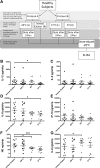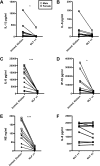Novel applications for a noninvasive sampling method of the nasal mucosa
- PMID: 28011618
- PMCID: PMC5336583
- DOI: 10.1152/ajplung.00476.2016
Novel applications for a noninvasive sampling method of the nasal mucosa
Abstract
Reliable methods for sampling the nasal mucosa provide clinical researchers with key information regarding respiratory biomarkers of exposure and disease. For quick and noninvasive sampling of the nasal mucosa, nasal lavage (NL) collection has been widely used as a clinical tool; however, limitations including volume variability, sample dilution, and storage prevent NL collection from being used in nonlaboratory settings and analysis of low abundance biomarkers. In this study, we optimize and validate a novel methodology using absorbent Leukosorb paper cut to fit the nasal passage to extract epithelial lining fluid (ELF) from the nasal mucosa. The ELF sampling method limits the dilution of soluble mediators, allowing quantification of both high- and low-abundance soluble biomarkers such as IL-1β, IL-8, IL-6, interferon gamma-induced protein 10 (IP-10), and neutrophil elastase. Additionally, we demonstrate that this method can successfully detect the presence of respiratory pathogens such as influenza virus and markers of antibiotic-resistant bacteria in the nasal mucosa. Efficacy of ELF collection by this method is not diminished in consecutive-day sampling, and percent recovery of both recombinant IL-8 and soluble mediators are not changed despite freezing or room temperature storage for 24 h. Our results indicate that ELF collection using Leukosorb paper sampling of ELF provides a sensitive, easy-to-use, and reproducible methodology to collect concentrated amounts of soluble biomarkers from the nasal mucosa. Moreover, the methodology described herein improves upon the standard NL collection method and provides researchers with a novel tool to assess changes in nasal mucosal host defense status.
Keywords: biomarkers; epithelial lining fluid; innate immune status; nasal mucosa; storage conditions.
Copyright © 2017 the American Physiological Society.
Figures





Similar articles
-
Influences of nasal lavage collection-, processing- and storage methods on inflammatory markers--evaluation of a method for non-invasive sampling of epithelial lining fluid in cystic fibrosis and other respiratory diseases.J Immunol Methods. 2014 Feb;404:41-51. doi: 10.1016/j.jim.2013.12.003. Epub 2013 Dec 23. J Immunol Methods. 2014. PMID: 24370751
-
Ivacaftor Reduces Inflammatory Mediators in Upper Airway Lining Fluid From Cystic Fibrosis Patients With a G551D Mutation: Serial Non-Invasive Home-Based Collection of Upper Airway Lining Fluid.Front Immunol. 2021 May 5;12:642180. doi: 10.3389/fimmu.2021.642180. eCollection 2021. Front Immunol. 2021. PMID: 34025651 Free PMC article. Clinical Trial.
-
Estimation of nasal epithelial lining fluid using urea as a marker.J Allergy Clin Immunol. 1993 Sep;92(3):457-65. doi: 10.1016/0091-6749(93)90125-y. J Allergy Clin Immunol. 1993. PMID: 8360397 Clinical Trial.
-
Collection of nasal secretions and tears and their use in allergology.Curr Opin Allergy Clin Immunol. 2018 Feb;18(1):1-9. doi: 10.1097/ACI.0000000000000412. Curr Opin Allergy Clin Immunol. 2018. PMID: 29135513 Review.
-
Objective monitoring of nasal airway inflammation in rhinitis.J Allergy Clin Immunol. 2005 Mar;115(3 Suppl 1):S414-41. doi: 10.1016/j.jaci.2004.12.1134. J Allergy Clin Immunol. 2005. PMID: 15746881 Review.
Cited by
-
SARS-CoV-2 Infection in Health Care Personnel and Their Household Contacts at a Tertiary Academic Medical Center: Protocol for a Longitudinal Cohort Study.JMIR Res Protoc. 2021 Apr 30;10(4):e25410. doi: 10.2196/25410. JMIR Res Protoc. 2021. PMID: 33769944 Free PMC article.
-
The Nose Knows: Sniffing out the Unique Immunological Risk of Alternative Tobacco Products.Am J Respir Cell Mol Biol. 2022 Apr;66(4):461-464. doi: 10.1165/rcmb.2021-0368LE. Am J Respir Cell Mol Biol. 2022. PMID: 35361069 Free PMC article. No abstract available.
-
A pilot study of the cardiopulmonary effects in healthy volunteers after exposure to high levels of PM2.5 in a New York City subway station.Part Fibre Toxicol. 2024 Oct 8;21(1):42. doi: 10.1186/s12989-024-00594-6. Part Fibre Toxicol. 2024. PMID: 39379984 Free PMC article.
-
Cytokine signature clusters as a tool to compare changes associated with tobacco product use in upper and lower airway samples.Am J Physiol Lung Cell Mol Physiol. 2022 May 1;322(5):L722-L736. doi: 10.1152/ajplung.00299.2021. Epub 2022 Mar 23. Am J Physiol Lung Cell Mol Physiol. 2022. PMID: 35318855 Free PMC article.
-
Nasal interferon responses to community rhinovirus infections are similar in controls and children with asthma.Ann Allergy Asthma Immunol. 2021 Jun;126(6):690-695.e1. doi: 10.1016/j.anai.2021.01.023. Epub 2021 Jan 27. Ann Allergy Asthma Immunol. 2021. PMID: 33515711 Free PMC article.
References
-
- Atlas LT. Description of apparatus and method for obtaining nasal washings. J Lab Clin Med 32: 1016–1023, 1947. - PubMed
MeSH terms
Substances
Grants and funding
LinkOut - more resources
Full Text Sources
Other Literature Sources
Medical

